height Hyundai Elantra 2017 Owner's Manual - RHD (UK. Australia)
[x] Cancel search | Manufacturer: HYUNDAI, Model Year: 2017, Model line: Elantra, Model: Hyundai Elantra 2017Pages: 571, PDF Size: 65.66 MB
Page 31 of 571
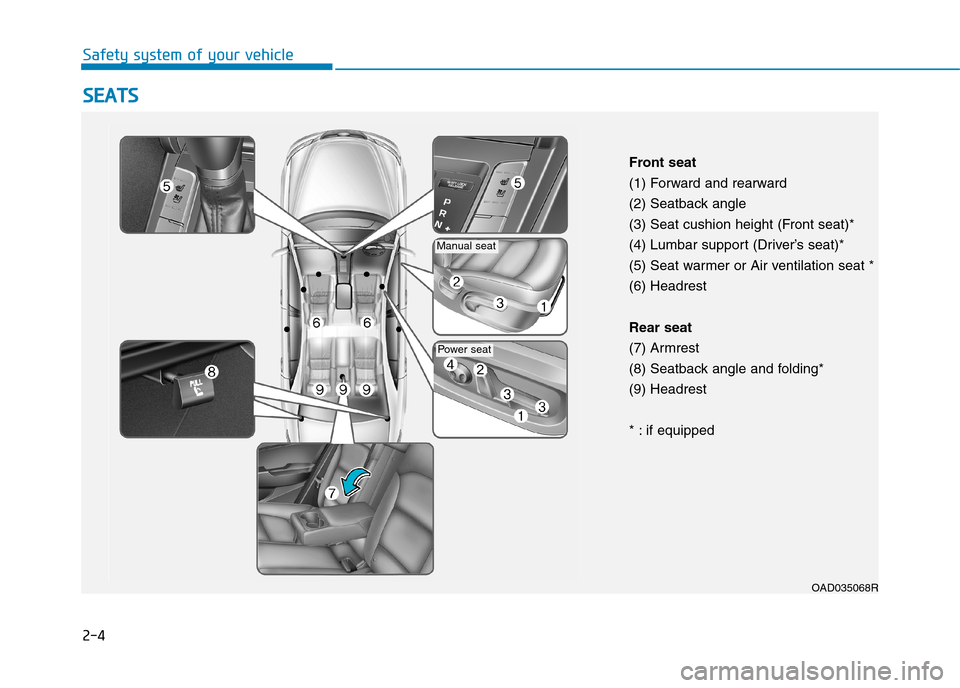
2-4
SSEEAATTSS
Safety system of your vehicle
OAD035068R
Front seat
(1) Forward and rearward
(2) Seatback angle
(3) Seat cushion height (Front seat)*
(4) Lumbar support (Driver’s seat)*
(5) Seat warmer or Air ventilation seat *
(6) Headrest
Rear seat
(7) Armrest
(8) Seatback angle and folding*
(9) Headrest
* : if equipped
Power seat
Manual seat
Page 36 of 571
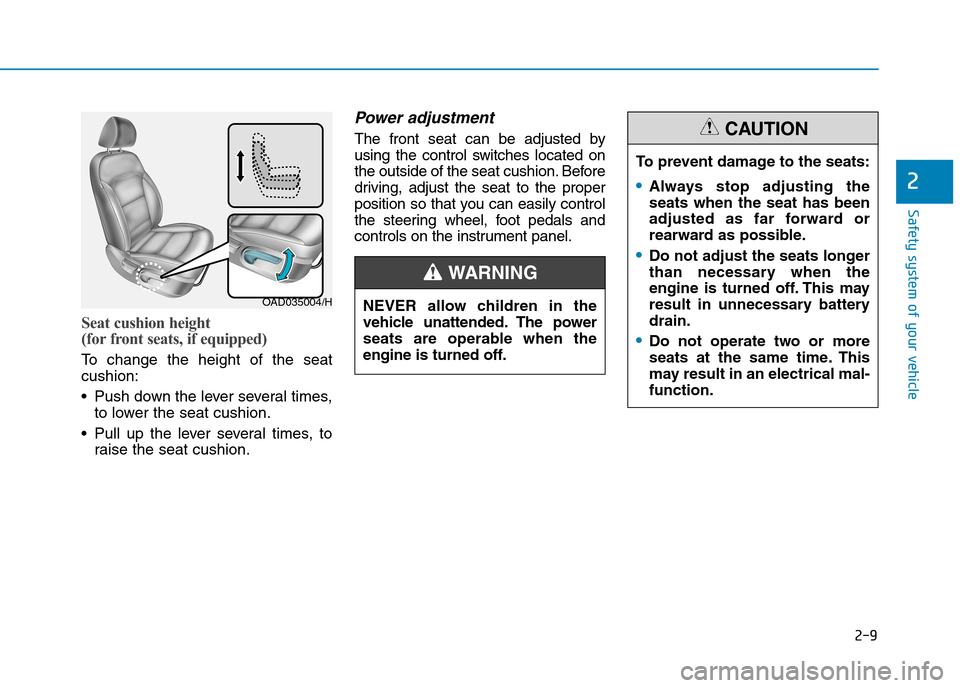
2-9
Safety system of your vehicle
Seat cushion height
(for front seats, if equipped)
To c h a n g e t h e h e i g h t o f t h e s e a t
cushion:
•Push down the lever several times,
to lower the seat cushion.
•Pull up the lever several times, to
raise the seat cushion.
Power adjustment
The front seat can be adjusted by
using the control switches located on
the outside of the seat cushion. Before
driving, adjust the seat to the proper
position so that you can easily control
the steering wheel, foot pedals and
controls on the instrument panel.
2
OAD035004/H
To p r e v e n t d a m a g e t o t h e s e a t s :
•Always stop adjusting the
seats when the seat has been
adjusted as far forward or
rearward as possible.
•Do not adjust the seats longer
than necessary when the
engine is turned off. This may
result in unnecessary battery
drain.
•Do not operate two or more
seats at the same time. This
may result in an electrical mal-
function.
CAUTION
NEVER allow children in the
vehicle unattended. The power
seats are operable when the
engine is turned off.
WA R N I N G
Page 38 of 571

2-11
Safety system of your vehicle
2
Seat belts must be snug against your
hips and chest to work properly.
When the seatback is reclined, the
shoulder belt cannot do its job
because it will not be snug against
your chest. Instead, it will be in front
of you. During an accident, you could
be thrown into the seat belt, causing
neck or other injuries.
The more the seatback is reclined,
the greater chance the passenger’s
hips will slide under the lap belt or
the passenger’s neck will strike the
shoulder belt.Seat cushion height
To c h a n g e t h e h e i g h t o f t h e s e a t
cushion:
1. Pull the front portion of the control
switch up to raise or push down to
lower the front part of the seat
cushion.
Pull the rear portion of the control
switch up to raise or push down to
lower the height of the seat cush-
ion.
2. Release the switch once the seat
reaches the desired position.
Lumbar support
•The lumbar support can be adjust-
ed by pressing the lumbar support
switch.
•Press the front portion of the
switch (1) to increase suppor t or
the rear portion of the switch (2) to
decrease support.
The lumbar support does not operate
up or down when the lumbar support
is in the rearmost position.
In this case, to use the system, slight-
ly increase support by pushing the
front portion of the switch (1).
OAD035007/HOAD035008R
Page 42 of 571
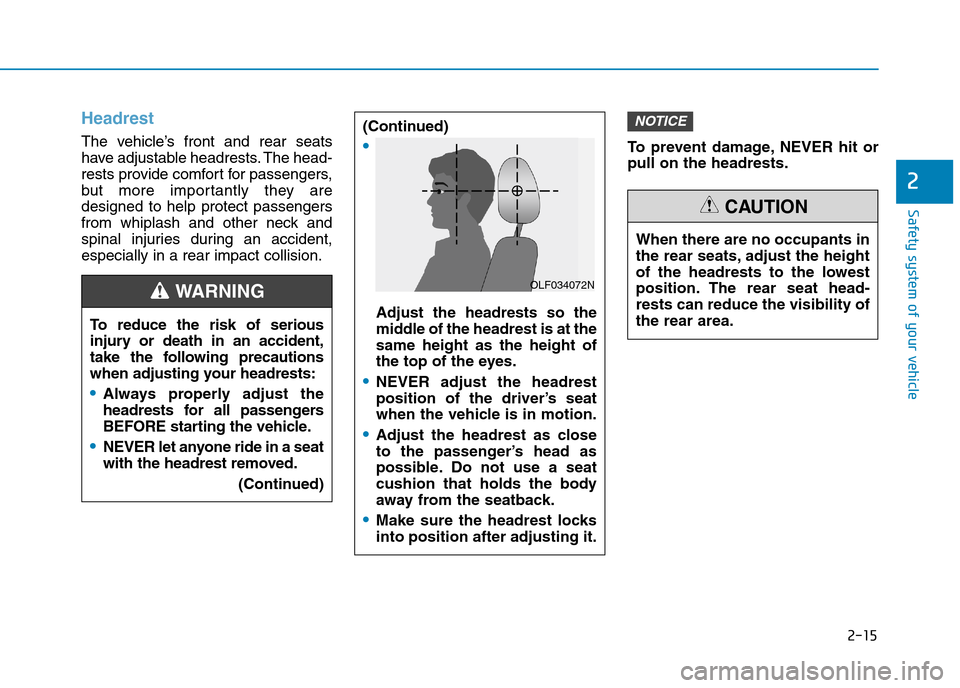
2-15
Safety system of your vehicle
2
Headrest
The vehicle’s front and rear seats
have adjustable headrests. The head-
rests provide comfort for passengers,
but more impor tantly they are
designed to help protect passengers
from whiplash and other neck and
spinal injuries during an accident,
especially in a rear impact collision.
To p r e v e n t d a m a g e , N E V E R h i t o r
pull on the headrests.
NOTICE(Continued)
•
Adjust the headrests so the
middle of the headrest is at the
same height as the height of
the top of the eyes.
•NEVER adjust the headrest
position of the driver’s seat
when the vehicle is in motion.
•Adjust the headrest as close
to the passenger’s head as
possible. Do not use a seat
cushion that holds the body
away from the seatback.
•Make sure the headrest locks
into position after adjusting it.
OLF034072N
To r e d u c e t h e r i s k o f s e r i o u s
injury or death in an accident,
take the following precautions
when adjusting your headrests:
•Always properly adjust the
headrests for all passengers
BEFORE starting the vehicle.
•NEVER let anyone ride in a seat
with the headrest removed.
(Continued)
WA R N I N G
When there are no occupants in
the rear seats, adjust the height
of the headrests to the lowest
position. The rear seat head-
rests can reduce the visibility of
the rear area.
CAUTION
Page 43 of 571

2-16
Safety system of your vehicle
Front seat headrests
The driver’s and front passenger’s
seats are equipped with adjustable
headrests for their safety and com-
for t.
Adjusting the height up and down
To r a i s e t h e h e a d r e s t :
1. Pull it up to the desired position (1).
To l o w e r t h e h e a d r e s t :
1. Push and hold the release button
(2) on the headrest support.
2. Lower the headrest to the desired
position (3).
If you recline the seatback towards
the front with the head restraint
and seat cushion raised, the head
restraint may come in contact with
the sunvisor or other parts of the
vehicle.
NOTICE
OAD035010OLF034015
OLMB033009
Page 44 of 571
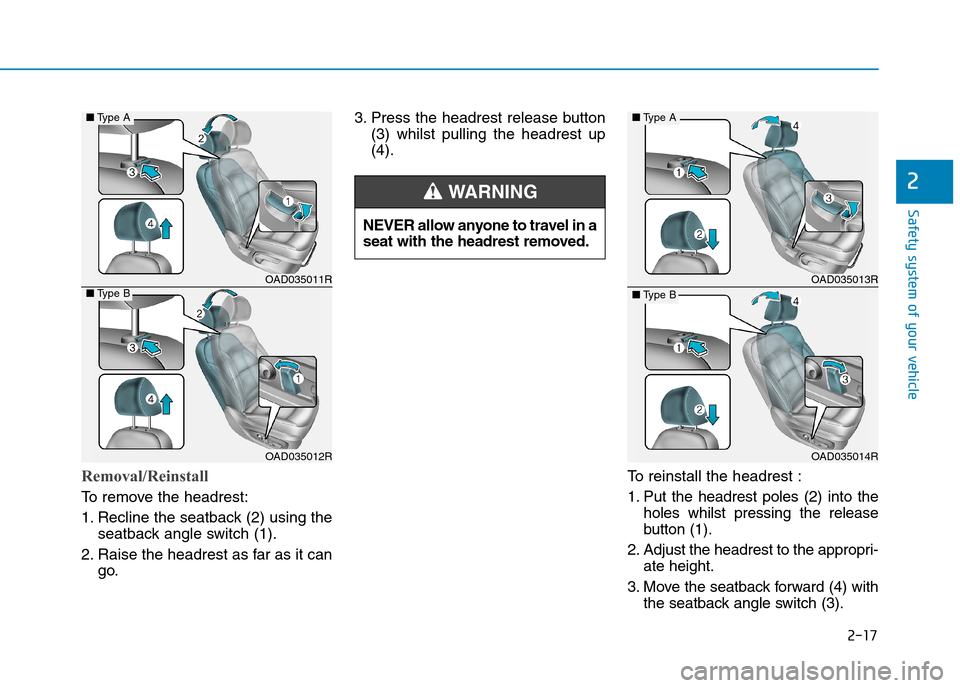
2-17
Safety system of your vehicle
Removal/Reinstall
To r e m o v e t h e h e a d r e s t :
1. Recline the seatback (2) using the
seatback angle switch (1).
2. Raise the headrest as far as it can
go.
3. Press the headrest release button
(3) whilst pulling the headrest up
(4).
To r e i n s t a l l t h e h e a d r e s t :
1. Put the headrest poles (2) into the
holes whilst pressing the release
button (1).
2. Adjust the headrest to the appropri-
ate height.
3. Move the seatback forward (4) with
the seatback angle switch (3).
2
NEVER allow anyone to travel in a
seat with the headrest removed.
WA R N I N G
OAD035011R
OAD035012R
■Ty p e A
■Ty p e BOAD035013R
OAD035014R
■Ty p e A
■Ty p e B
Page 45 of 571

2-18
Rear seat headrests
The rear seats are equipped with
headrests in all the seating positions
for passengers safety and comfor t.
Adjusting the height up and down
(if equipped)
To r a i s e t h e h e a d r e s t :
1. Pull it up to the desired position (1).
To l o w e r t h e h e a d r e s t :
1. Push and hold the release button
(2) on the headrest support.
2. Lower the headrest to the desired
position (3).
Safety system of your vehicle
OLMB033016
OAD035018
Always make sure the headrest
locks into position after rein-
stalling and adjusting it properly.
WA R N I N G
Page 55 of 571
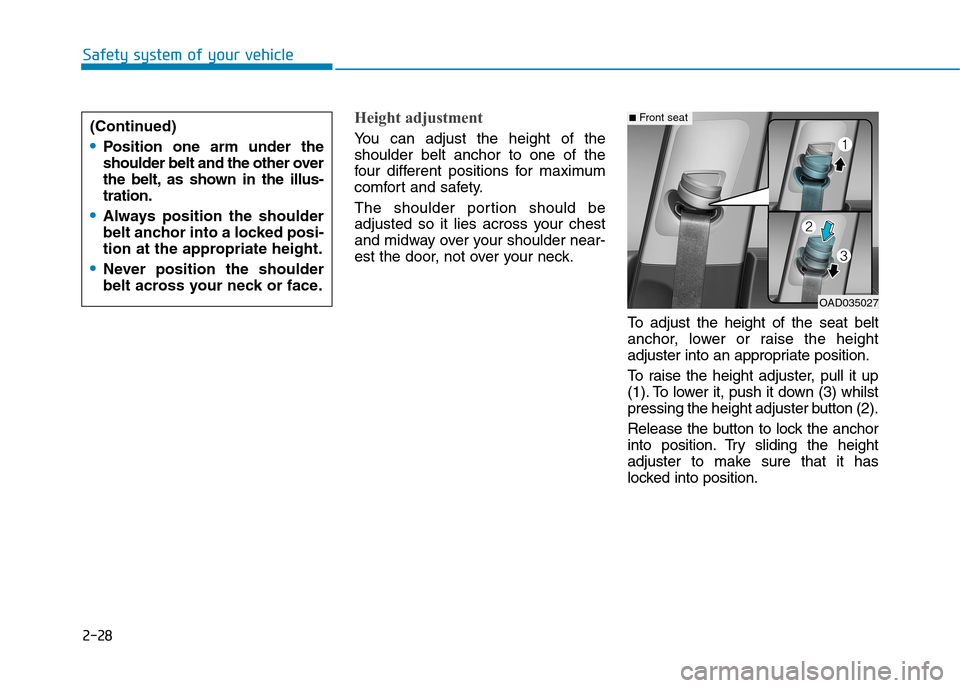
2-28
Safety system of your vehicle
Height adjustment
Yo u c a n a d j u s t t h e h e i g h t o f t h e
shoulder belt anchor to one of the
four different positions for maximum
comfort and safety.
The shoulder portion should be
adjusted so it lies across your chest
and midway over your shoulder near-
est the door, not over your neck.
To a d j u s t t h e h e i g h t o f t h e s e a t b e l t
anchor, lower or raise the height
adjuster into an appropriate position.
To r a i s e t h e h e i g h t a d j u s t e r , p u l l i t u p
(1). To lower it, push it down (3) whilst
pressing the height adjuster button (2).
Release the button to lock the anchor
into position. Try sliding the height
adjuster to make sure that it has
locked into position.
OAD035027
■Front seat(Continued)
•Position one arm under the
shoulder belt and the other over
the belt, as shown in the illus-
tration.
•Always position the shoulder
belt anchor into a locked posi-
tion at the appropriate height.
•Never position the shoulder
belt across your neck or face.
Page 59 of 571

2-32
Safety system of your vehicle
Additional seat belt safety pre-
cautions
Seat belt use during pregnancy
Seat belts should always be used
during pregnancy. The best way to
protect your unborn child is to protect
yourself by always wearing a seat
belt.
Pregnant women should always wear
a lap-shoulder seat belt. Place the
shoulder belt across your chest and
away from your neck. Place the lap
belt below your belly so that it fits
SNUGLY across your hips and pelvic
bone, under the rounded part of the
belly.
Seat belt use and children
Infant and small children
Most countries have child restraint
laws which require children to travel
in approved child restraint devices,
including booster seats. The age at
which seat belts can be used instead
of child restraints differs between
countries, so you should be aware of
the specific requirements in your
country, and where you are travel-
ling. Infant and child restraints must
be properly placed and installed in a
rear seat. For more information refer
to the “Child Restraint Systems” in
this chapter.
To r e d u c e t h e r i s k o f s e r i o u s
injury or death to an unborn
child during an accident, preg-
nant women should NEVER
place the lap portion of the seat
belt above or over the area of
the abdomen where the unborn
child is located.
WA R N I N G
ALWAYS properly restrain infants
and small children in a child
restraint appropriate for the
child’s height and weight.
To r e d u c e t h e r i s k o f s e r i o u s
injury or death to a child and
other passengers, NEVER hold a
child in your lap or arms when
the vehicle is moving. The violent
forces created during an acci-
dent will tear the child from your
arms and throw the child against
the interior of the vehicle.
WA R N I N G
Page 60 of 571
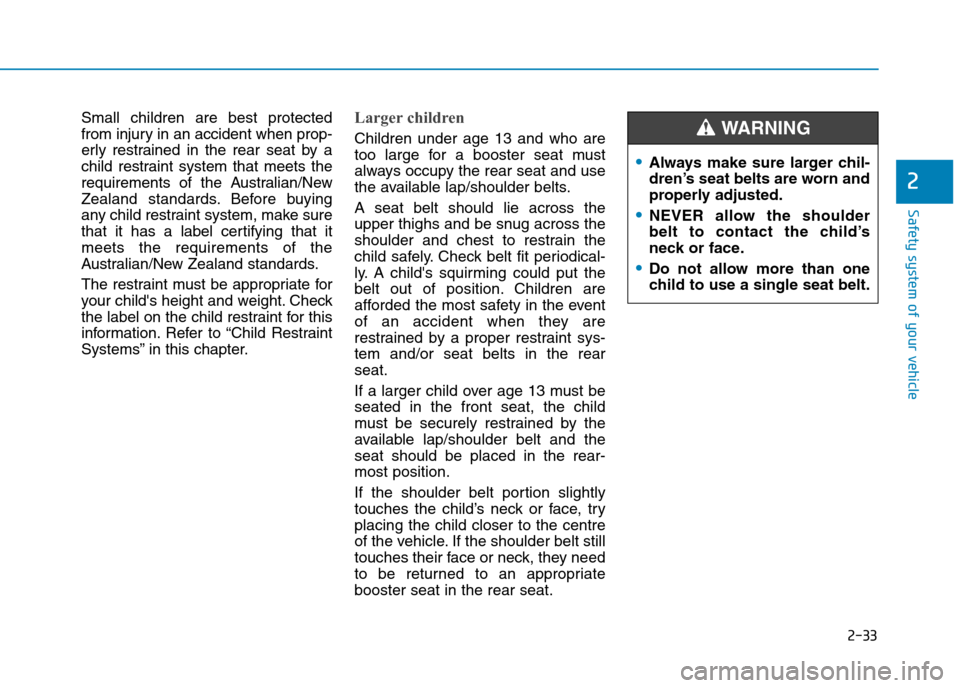
2-33
Safety system of your vehicle
2
Small children are best protected
from injury in an accident when prop-
erly restrained in the rear seat by a
child restraint system that meets the
requirements of the Australian/New
Zealand standards. Before buying
any child restraint system, make sure
that it has a label certifying that it
meets the requirements of the
Australian/New Zealand standards.
The restraint must be appropriate for
your child's height and weight. Check
the label on the child restraint for this
information. Refer to “Child Restraint
Systems” in this chapter.
Larger children
Children under age 13 and who are
too large for a booster seat must
always occupy the rear seat and use
the available lap/shoulder belts.
A seat belt should lie across the
upper thighs and be snug across the
shoulder and chest to restrain the
child safely. Check belt fit periodical-
ly. A child's squirming could put the
belt out of position. Children are
afforded the most safety in the event
of an accident when they are
restrained by a proper restraint sys-
tem and/or seat belts in the rear
seat.
If a larger child over age 13 must be
seated in the front seat, the child
must be securely restrained by the
available lap/shoulder belt and the
seat should be placed in the rear-
most position.
If the shoulder belt portion slightly
touches the child’s neck or face, try
placing the child closer to the centre
of the vehicle. If the shoulder belt still
touches their face or neck, they need
to be returned to an appropriate
booster seat in the rear seat.
•Always make sure larger chil-
dren’s seat belts are worn and
properly adjusted.
•NEVER allow the shoulder
belt to contact the child’s
neck or face.
•Do not allow more than one
child to use a single seat belt.
WA R N I N G